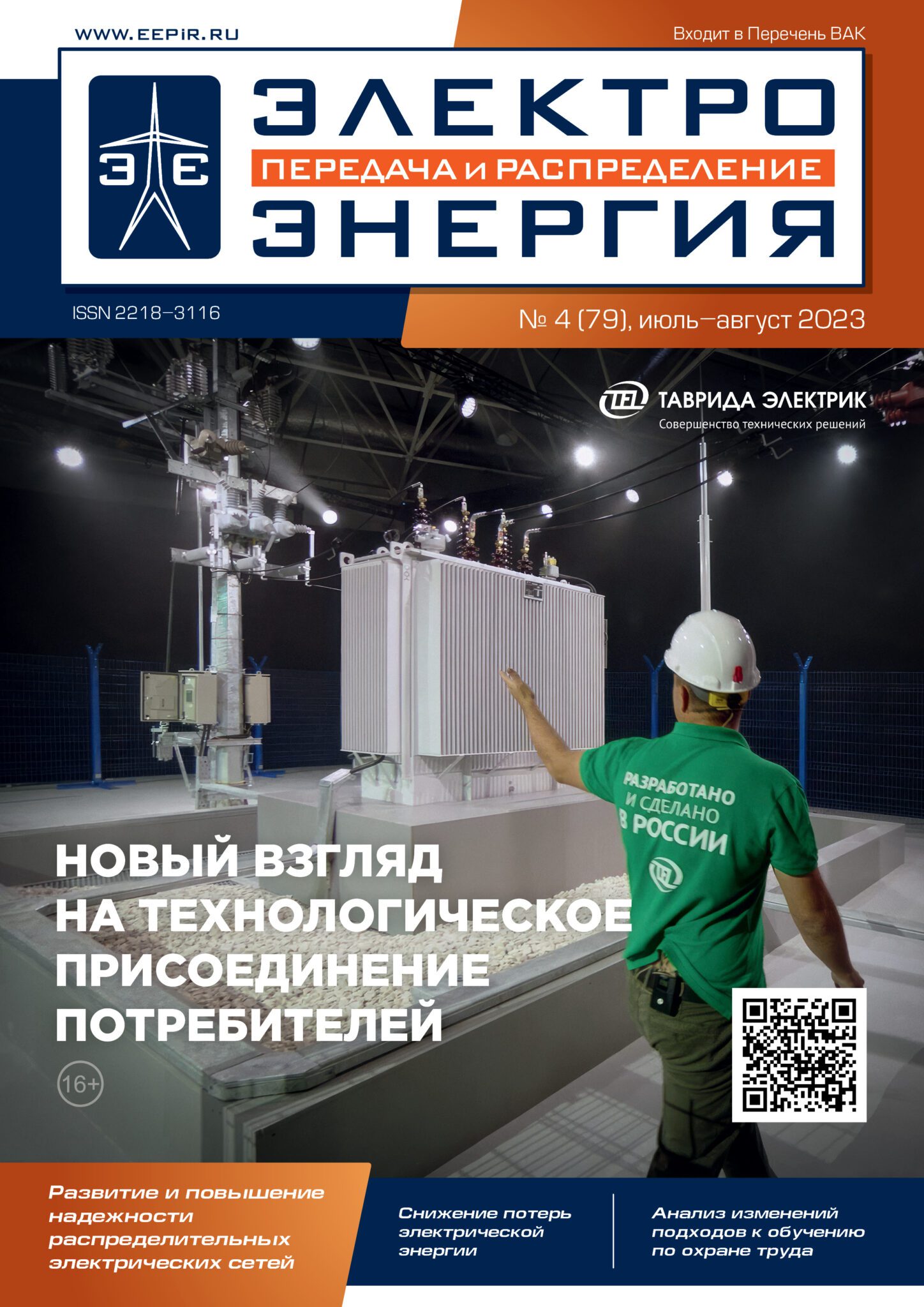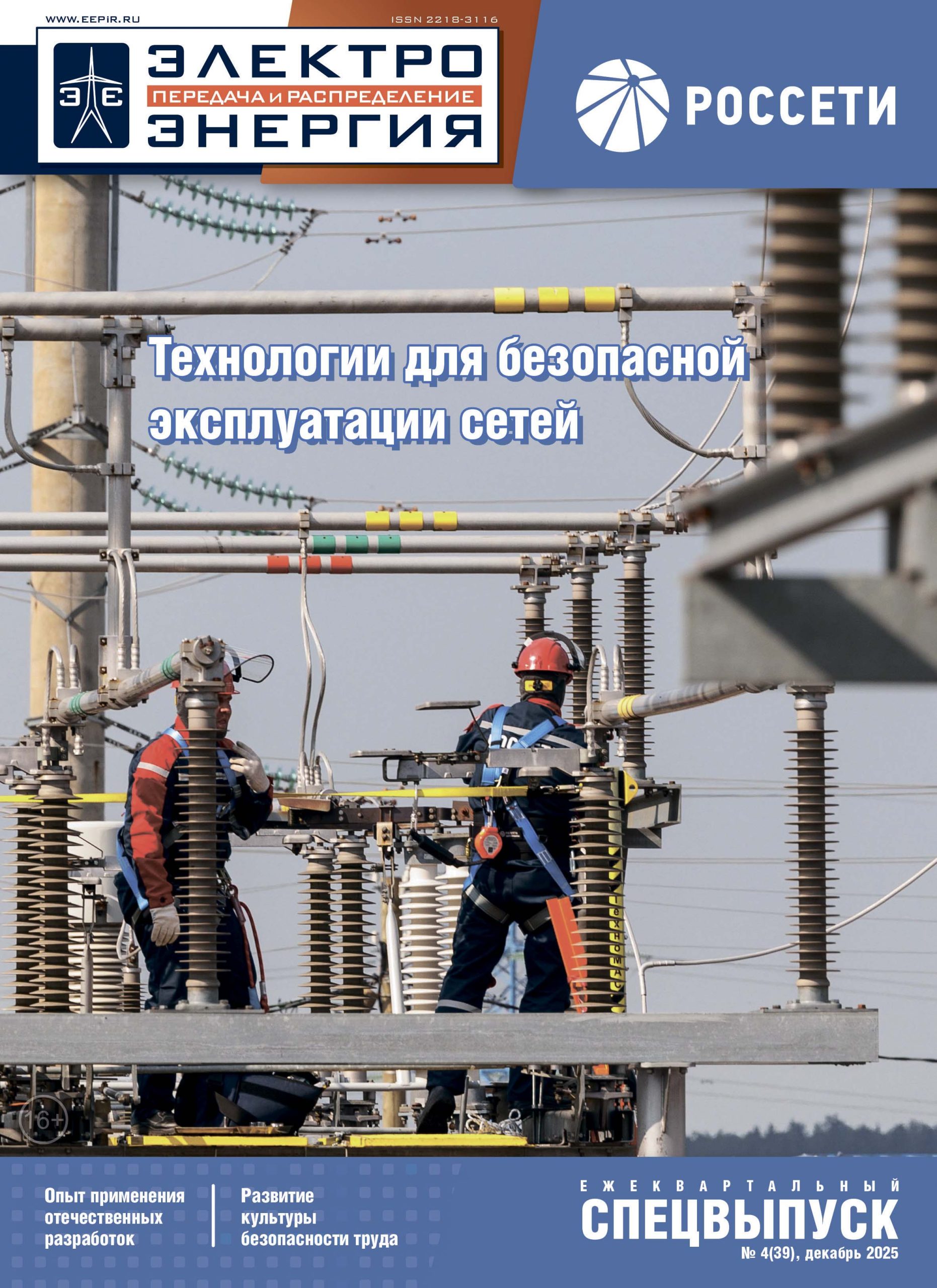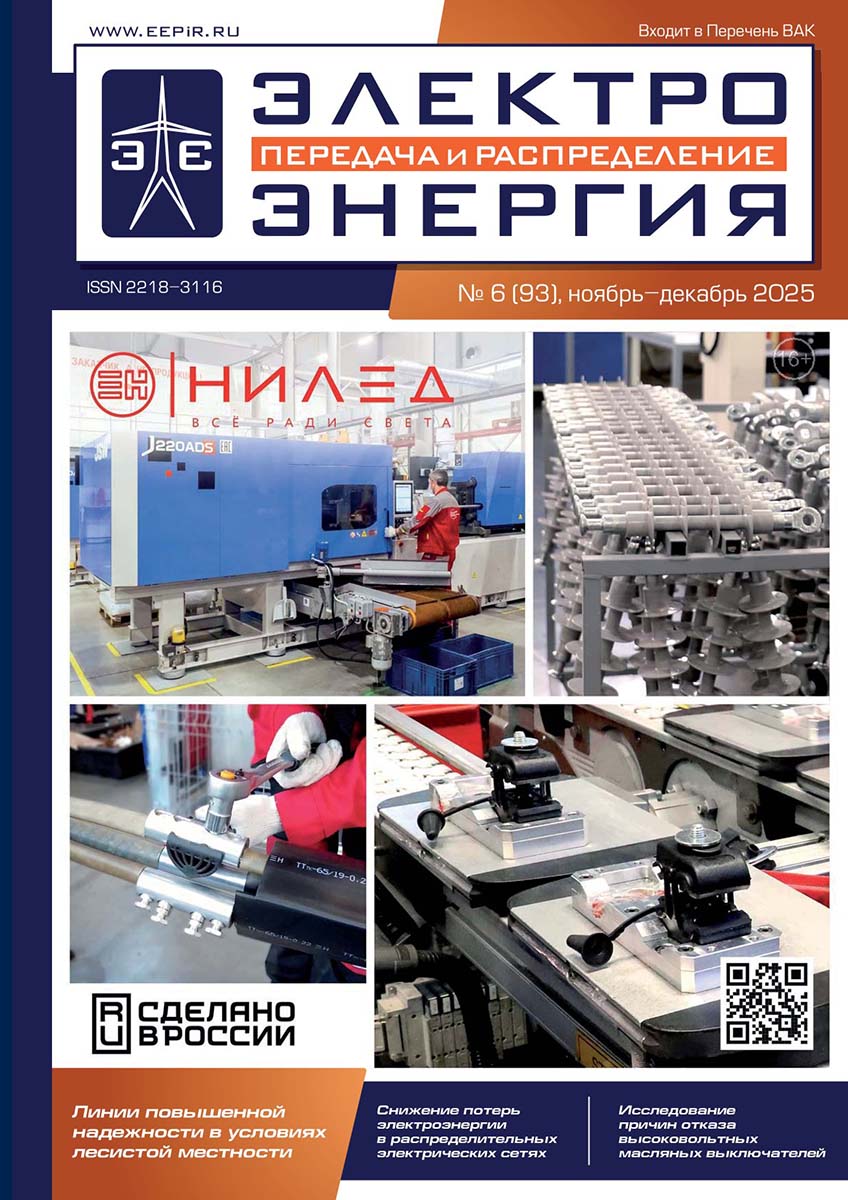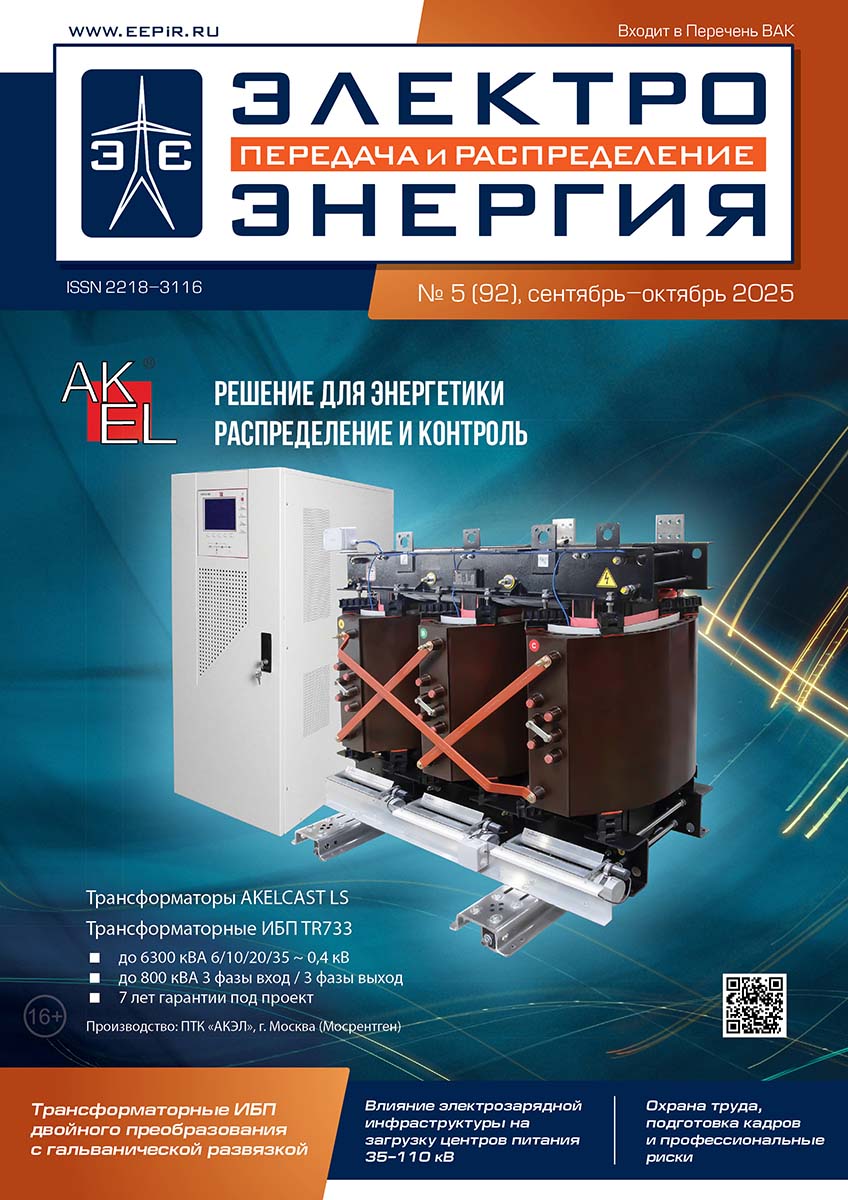
29 августа 2023
«ЭЛЕКТРОЭНЕРГИЯ. Передача и распределение» № 4(79), июль-август 2023
СОБЫТИЯ
ВОЗОБНОВЛЯЕМАЯ ЭНЕРГИЯ
ВОЗОБНОВЛЯЕМАЯ ЭНЕРГИЯ
ВОЗОБНОВЛЯЕМАЯ ЭНЕРГИЯ
УПРАВЛЕНИЕ СЕТЯМИ
КАЧЕСТВО ЭЛЕКТРОЭНЕРГИИ
КАЧЕСТВО ЭЛЕКТРОЭНЕРГИИ
УЧЕТ ЭЛЕКТРОЭНЕРГИИ
УЧЕТ ЭЛЕКТРОЭНЕРГИИ
ВОЗДУШНЫЕ ЛИНИИ
ВОЗДУШНЫЕ ЛИНИИ
ВОЗДУШНЫЕ ЛИНИИ
КАБЕЛЬНЫЕ ЛИНИИ
ОБОРУДОВАНИЕ
ОБОРУДОВАНИЕ
ДИАГНОСТИКА И МОНИТОРИНГ
ПОДГОТОВКА КАДРОВ
ОХРАНА ТРУДА
EVENTS
VIII International Scientific and Technical Conference «Development and Reliability Improvement of Distribution Network« and EEPIR Technical Exhibition
Event overview
A New Approach to the Process Connection of Consumers from the Tavrida Electric Company
Report from Think Smart 2023 technology show
RENEWABLE ENERGY
Renewable Energy Communities: Effective Design and Management Under Multicriteria Conditions. Part 2
Tomin N.V., Shakirov V.A., Kurbatsky V.G., Popova E.V., Sidorov D.N., Kozlov A.V. (Melentiev Energy Systems Institute SB RAS, Irkutsk) Korev D.A. (PJSC RusHydro)
Abstract. Energy communities are associations of several territorially close microgrids, whose consumers have the opportunity to exchange surplus energy produced, including using renewable sources. The efficiency of functioning and the duration of the aggregation of such a community is determined by a number of economic, environmental, social and technical factors that must be taken into account, both at the stage of its design and at the subsequent stage of operational management. In the first part of the presented article, a detailed analysis of new approaches and examples of design energy communities in the world and in Russia was carried out. Modern multi-criteria approaches to the creation and management of energy communities are considered. On the basis of the conducted analytical studies, a conclusion is made about the need to develop multi-criteria approaches to the design and management of energy communities, taking into account the various interests of its participants. Promising tools for solving this nontrivial problem are the methods of multicriteria decision making, multicriteria optimization, and artificial intelligence. In the second part of the article, a unified multi-criteria approach to design and optimal management of the renewable energy community proposed by the authors will be considered, taking into account many complicating factors. Its effectiveness will be demonstrated on a numerical example for three remote villages in Primorsky Krai.
Keywords: energy community, microgrid, renewable energy, multi-criteria choice, multi-objective optimization, reinforcement learning, zero carbon emissions, local market, bilevel optimization
The Process Control System Intended for Electric Energy Storage Systems is the Key Component of the Power Infrastructure
ENELT Group of companies
Analysis of factors that reduce the energy efficiency of wind power plants
Shpenst V.A., Ermolovich V.S. (Saint Petersburg mining university)
Abstract. The article considers the influence of weather and climatic conditions on the reliability of wind turbines. As a result of the analysis, it was revealed that the most vulnerable to failure elements of the wind turbine are the control and monitoring systems. Also in the article, the influence of the occurrence of ice on the blades of wind turbines on the overall undersupply of electricity was considered. It has been found that icing on the blades can cause increased noise and vibration, overloading the generator, reducing power output, as well as stopping the operation of the wind turbine as a whole.
Keywords: wind turbines, energy efficiency, fault, icing of blades
GRIDS MANAGEMENT
Predictive management of accident elimination in PJSC Rosseti Moscow Region
POWER QUALITY
Analysis of Frequency Deviations, Voltage Harmonic Distortion and Unbalance in the Off-grid Power System of an Oil Production Enterprise
Zyryanov V.M., Nesterenko G.B., Prankevich G.A., Khatylenko R.M. (NSTU NETI)
Abstract. The problem of electric power quality in modern off-grid power systems has been reviewed. The mode parameters monitoring results in the off-grid power system of an oil production enterprise including diesel power plant, which supplies drilling rig system BU-4500/270 EKBM have been presented. The active power load diagram analysis of the diesel power plant and the analysis of frequency deviations, voltage harmonic distortion and unbalance have been conducted during normal technological operations of the well drilling. Multiple deviations of electric power quality indicators from normalized values have been revealed, the reasons for the occurrence of such a situation have been considered. In addition, the analysis results showed that application of the gas piston units in such a power system without revising the number and power of the generator units or without using the electric energy storage system is not allowed due to the sudden changes in the load power.
Keywords: electric power quality, off-grid power system, oil field, abruptly variable load, drilling rig, diesel power plant, electrical energy storage system
Methods of Forming the Mathematic Model of a Power Grid for the Non-sinusoidal Steady Mode Calculation and the Resonance Study. Part 1. The Algorithm and the Practical Issues of Simulation
Solodovnikov V.E. (OOO ETS-Energo), Flerov A.N. (JSC Rosseti Tyumen), Tulskiy V.N. (NRU MPEI), Shamonov R.G. (PJSC FGC UES), Korolev A.A. (Russian University of Transport (MIIT))
Abstract. Electrical power systems feeding large non-linear loads typically feature widespread and persistent violation of permissible voltage harmonic distortion levels, and transmission grids (over 110 kV) are no exception in this case. At the same time, practical approaches to development of power system harmonic models tend to be oversimplified, making it possible to obtain only pretty rough estimates of resonant frequencies and expected values of voltage and current harmonic factors, which reduces the effectiveness of the mitigation measures significantly. Therefore, a method of power system harmonic model development is proposed in this article in order to eliminate such risk.
Keywords: power quality, higher harmonics, voltage & current harmonic distortion, resonance, power system operational conditions, power system modeling
ELECTRIC POWER METERING
State-of-the-art Efficiency of Data Oriented Methods for Non-technical Electricity Losses Detection
Samoylenko V.O., Verkhozin A.M., Tashchilin V.A., Pazderin A.V., Mukhlynin N.D. (Ural Federal University, Ekaterinburg)
Abstract. The paper considers state-of-the-art efficiency of data oriented methods for non-technical electricity losses detection. It compares the main mathematical methods for detection of non-technical energy losses and provides the metrics for their assessment, the features of initial data processing, and models (patterns) of electric energy theft. The most commonly used types of artificial neural networks and their settings for detection of non-technical energy losses are examined. A computational case study is conducted and reproduced step by step proposing a new modified method for non-technical energy losses detection based on an convolutional autoencoder. The results of the paper are urgent for the development of a software non-technical electricity losses detection in distribution grids.
Keywords: non-technical energy losses, energy frauds, electricity theft, electricity metering, metering error, distribution grids
Fighting the Electricity Theft by Means of a Complex Solution from MTS
PLC+RF Hybrid Communication Channel: a Solution from the Production Holding Energomera Aimed for the Optimal Function of the Intelligent Energy Metering System
OVERHEAD TRANSMISSION LINES
The Need for Improving the Regulatory Control in the Power Industry
OOO PO Energozhelezobetoninvest
Use of Simulation Methods for the Reliability Parameter Calculation in Implementing Projects on 6-20 kV Overhead Transmission Line Distributed Automation
Encore Engineering (OOO TransEnergoSnab)
Centralized Solution for 6-10 kV Distribution Network Automation with the use of Smart Circuit-breakers and Load Isolators
Antraks Group
Research and Production Enterprise «Avis» – 10 Years in the Market of Electromechanical Products
Application of a New Generation of High-temperature Wires in Existing OHLs in Conditions of Load Maxima Shift in the Winter-to-summer Period
OOO Metsbytservis, Volgograd State Technical University (VSTU), OOO Tehprispro, JSC NTTS FGC UES
CABLE LINES
Issues of Choosing the Cross-Section of 6-500 kV Cable Screens
Dmitriev M.V.
Abstract. The article is intended to draw attention to the fact that if there is significant uncertainty in the key source data when designing cable lines, then it makes no sense to use complex thorough methods of calculating and selecting cables – it is quite acceptable to replace them with simplified ones. One example is the choice of the screen cross section of single-phase high-voltage cables. When choosing a screen, the «exact» complex methodology of GOST R IEC 60949-2009 is used, which allows, by modeling cable cooling, to refine the cross-section of the screen by 10-20% compared to what simple formulas give. However, at the same time, both calculation methods use unreasonable values of the short-circuit current and its shutdown time, which can change the screen cross-section up to 2-3 times compared to what is really necessary – against this background, the struggle for 10-20% related to accounting/non-accounting for cooling seems pointless at the moment.
Keywords: cable line, single-core cable, cross-linked polyethylene, screen cross-section, short circuit, non-adiabatic process
Continuous Permissible Current Load of HV Power Cable Lines in Conditions of the Pipe-block Canalization
Voloshin K.V., Greshnyakov G.V., Kizevetter D.V., Titkov V.V., Chesnokov E.A. (Peter the Great St. Petersburg Polytechnic University). Tukeev P.D. (JSC NIIEFA), Bushanova V.V., Khersontseva I.O. (PJSC Rosseti Lenenergo)
Abstract. The article describes the procedures of digital estimation of the continuous permissible current load of power cable lines in conditions of laying in pipe blocks adapted to applied common calculation means. The proposed technology is remarkable for correct consideration of all electromagnetic and thermophysical processes in a pipe block including eddy currents in cable shields and the armature, solid state, convectional and radioactive heat transfer in construction com[1]ponents of a pipe block by means of massive finite-element calculations and creation of a database that includes the cable product range for 6-20 kV, polymeric and chrysotile cement pipes used in pipe-block cable line canalization. The described calculation methods enable the online estimation of heating and continuous permissible currents of cable lines in a pipe block without using the metaphysical simulation.
Keywords: cable block, cable lines, pipe-block energy canalization, continuous permissible current, transfer capacity
RELAY PROTECTION AND AUTOMATION
Key Issues of Relay Protection
Overview of Session 5 «Relay protection and automation of electrical networks» within the VIII International Conference «Development and reliability improvement of distribution network»
EQUIPMENT
Production Modernization of Energy-efficient Amorphous Steel-cored Transformers
OOO NPK AVTOPRIBOR
Huaming Reliable Equipment for Critical Sites
Interview with Yatsenko A.V., Director General of Huaming LLC
Transformer chemistry
OOO Transformer
Air-blast Switches EKF ВА-45 v2 is a Reliable Protection of Power Facilities
ENERGOPROMALYANS – Never Stop Moving On
Neutral Modes and Ways to Improve the Operation Reliability of 6-35 kV Distribution Networks
Novosibirsk State Technical University NETI
DIAGNOSTICS AND MONITORING
Development and Efficiency Improvement of the Thermal Control of Contacts and Contact Connections in Distribution Network Installation Operation
JSC UNECO
PERSONNEL TRAINING
The Best Crew of Electricians has Been Appointed in Contracting Companies of Tatarstan
LABOR PROTECTION
Analysis of Changes in Approaches to the Training of Workers in the Energy Industry on Labor Protection
Kondrateva O.E., Loktionov O.A., Vasileva N.V., Miroshnichenko D.A., Kuznetsov N.S. (NRU MPEI)
Abstract. The article presents a comparative analysis of the previously existing approach to the workers training in the power industry on labor protection and the new approach regulated by the Decree of the Government of the Russian Federation dated 12/24/2021 No. 2464. There are described new types of training and educational modules, requirements for the duration and given availability of a practical component for each module, recommendations for the formation of the content of educational modules. The advantages of the new approach to occupational safety training are revealed and the main risks in its implementation are indicated.
Keywords: power industry, occupational safety training, occupational risk reduction, occupational safety management system
INDUSTRIAL INJURIES
Lessons Learned from Accidents
Russian Federal Service for Ecological, Technical and Atomic Supervision
ECOLOGY
Evaluation of the Development Potential of the Power NetZero by Example of the Own Generation Sites of PJSC «MMC «Norilsk Nickel»









